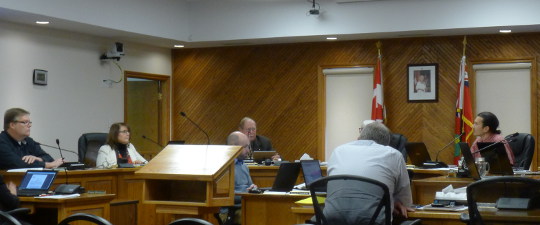Stephen Vance, Staff
Among the 66 service areas included in the municipal service delivery review is whether Meaford’s council is the right size to adequately serve themunicipality.
At their June 20 meeting, council received a report and presentation about the findings that have come out of the service delivery review regarding the size of council, as well as whether a ward system could or should be implemented in the municipality.
Meaford’s council has seven members – a Mayor, a Deputy Mayor, and five council members all elected at large. That is in line with most other municipalities in the region, according to the report presented to council.
With 9,953 electors in the municipality, Meaford currently has one council member for every 1,990 electors, also in line with other municipalities in the region.
Municipal ClerkRob Tremblaytold council that while Meaford is free to lower the number of councillors to five (the minimum allowed by the province) as has been done in Chatsworth, the relatively small savings that would be realized would come at a cost of reduced representation for Meaford electors. While Chatsworth has just five members on its council, its number of electors is significantly less than Meaford (6,182, or 1,236 electors per council member).
“The reduction in the size of council could represent a savings of approximately $50,000, inclusive of remuneration, payroll expenses, benefits, and mileage. In addition, 2/7 of the conference/training budget could be eliminated,” Tremblay noted in his report.
While the budget line for Meaford’s council is $307,300, that number can be deceiving given that the council budget also includes the annual community grant fund as well as funds for sponsorship of major events that take place in the municipality like Dragons’ Den Meaford, the Meaford International Film Festival, and the annual Scarecrow Invasion & Family Festival.
The portion of the council budget allotted to council remuneration is $152,775 each year.
A table included in the report compared the remuneration of council members in Meaford to surrounding municipalities.Meaford’s mayor earns annual remuneration of $33,331, while the deputy mayor earns $22,726, and regular councillors earn $21,223 per year. Those salaries compare favourably to other municipalities in the region where the median salary for a mayor is $36,358, and $23,740 for deputy mayors, with the median councillor salary in the region being $19,129 according to the report.
Members of council, who received the report for information purposes only and were not expected to make any decision with regard to the size of Meaford’s council at this stage, agreed that given the population, and the geographic size of the municipality, Meaford’s council appears to be right-sized.
“We have a very big municipality, we have a lot of ground to cover, we have a lot of people to see, and a lot of diverse area,” noted Councillor Tony Bell. “We need to have good representation for the people in our municipality.Chatsworth does have a smaller council; I believe by sheer math of having seven versus five, we have a higher probability of getting those difficult questions and things that come before us right with seven over five.”
Councillor Steven Bartley suggested that a council of five can place too much power in the hands of just a few.
“Two of the other municipalities (in our area) went to five (councillors), and if we were going to save a bit of money, I have no issues with that, but it’s a fact that there are issues with five because three people can get together and control the vote of everything that’s done,” suggested Bartley. “Three people in one of those municipalities control everything that’s done in that municipality, the other two might as well not be there.”
Also touched on was the possibility of moving to a ward system rather than the system currently in place which sees all members of council elected at large. Tremblay noted that while provincial legislation allows for a ward system to be used, transition to a ward system is complex, expensive, and is subject to challenge before the Ontario Municipal Board.
“Section 222 (of the Municipal Act) deals with the establishment of wards. It specifies notice and allows for an appeal to the Ontario Municipal Board. Section 223 allows for a citizens‘ petition to ask that the municipality be divided into wards. The signatures of one percent of the electors is required. With an elector count of 9952 from the 2014 election, 99 signatures would be required. Council has 90 days to act or any one of the signatories can appeal to the Ontario Municipal Board. Should such a review be undertaken, an expert consultant would be required with due consideration for the principle of effective representation set out by the Supreme Court of Canada. Simply reinstating old municipal boundaries that existed prior to amalgamation may not be appropriate or automatic,” Tremblay advised council in his report.
Councillor Bell agreed that a ward system should be avoided.
“No wards. We are one municipality, we are one people,” said Bell.












